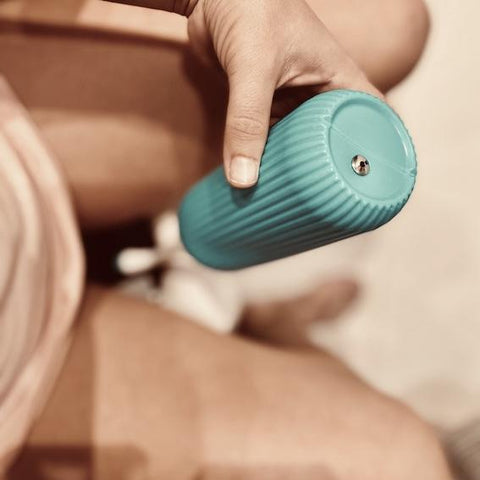How to maintain hygiene without pain after childbirth?
Maintaining good hygiene during the postpartum period is extremely important for your health and for the fastest and most comfortable recovery possible, but sometimes it is difficult to maintain the correct hygiene routine when just thinking about toilet paper gives us chills.
In such a new stage and so full of changes like being a mother, we tend to put ourselves in the background. The baby is already in your arms and now only his care matters, right? At We Are Mammas we are going to be very frank: if you are not well, the baby will not be well. You are still as important as before your baby was born. And that is why you have to take care of yourself, starting with your hygiene.
Ready to heal the birth points? Go for it.
Episiotomy should not cause you any problem if you maintain adequate care and hygiene. We know that something as simple as going to the bathroom is now going to be quite an adventure, but there are little things you can do to heal them in no time:
How to take care of stitches after childbirth
Maintaining hygiene is a crucial step in the cure of episiotomy. Washing your hands before proceeding to a cure or washing after going to the bathroom is extremely important. A daily shower is also recommended, but it is not advisable to wash more than twice a day, since excessive perineal hygiene can alter the natural flora of the skin and predisposes to vaginal infections. In addition, excess moisture in the area hinders healing.
Remember that hygiene should only be external, internal washing should never be done by introducing water or any product inside the vagina. Until it heals, apply only the water that comes out of the shower or your hygiene bulb , no stagnant water from the bathtub or bidet. Use neutral soap, a clean cotton towel that you must change every time (and not share with anyone) and dry by patting and not dragging, starting at the front of the vulva and ending at the anus. This will avoid carrying bacteria from the anal area to your perineum or the entrance of the vagina.
Apart from maintaining adequate hygiene, there are little tricks that you can apply in your day to day to make the episiotomy treatment more bearable, such as:
- Rest. It seems utopian, but doing it whenever you can will speed up healing.
- Use Dead Sea salts dissolved in warm water with showers as they will help keep the area clean of bacteria.
- Localized cold. Use cold packs for 10 minutes every 4 or 5 hours.
- Use organic cotton maternity pads.
How to go to the bathroom after childbirth
Doing minor waters and major waters is still vital for your body and, as much as it causes you anguish, it is a process that you will have to continue practicing.
Don't worry, we have the secrets that no one has told you so that going to the bathroom after an episiotomy is not an ordeal. Shall we start by going pee? Come on, you can.
Urinating after childbirth is not going to be a losing battle, not this time. There are many moms who have panicked just hearing the words toilet paper, but why continue to suffer? The best way to clean yourself after going to the bathroom is with a perineal bottle or hygiene bottle designed especially for us. It is comfortable, ergonomic, portable and made for super easy use.

With the perineal irrigation bottle these moments become more bearable and facilitate the postpartum self-care routine. A peri bottle will also help us keep the areas affected by childbirth, such as the perineum, safe from infections and promotes a faster recovery. It will be your best ally during the first trips to the bathroom after delivery.
All advantages
- Intimate hygiene: much better and softer than toilet paper
- Ergonomic Design: Specifically designed to be used upside down to avoid reaching into the toilet bowl.
- Large Capacity: Holds 450ml of water.
- Super Tip: Add a teaspoon of our Dead Sea Salts with Rosemary and Sage for extra relief.
Yes we know. Peeing is not everything. But we have a secret to tell you, the first major waters will no longer be feared. Goodbye pain, goodbye hemorrhoids, goodbye fear. No, we have not gone crazy, it is that we know what 35º of inclination is.
No more postpartum hemorrhoids!
Our ancestors, who were undoubtedly much more connected to nature and our physiology than we are, knew that the best position to go to the bathroom is squatting. And it is that the 35º angle that is formed between the legs and the body makes that all the parts that participate in the evacuation process are well aligned. An anatomical golden ratio that humans have been ignoring for centuries!
Knowing that...
- 44% of pregnant women suffer from constipation from the second trimester.
- 47% suffer from constipation and hemorrhoids after a vaginal delivery.
- 57% suffer from constipation and hemorrhoids after a cesarean section.
...at We Are Mammas we have not been able to sit idly by. So we have squatted!
That is why our stool is handmade Made In Spain with local artisans, 100% wood from sustainable forestry. It is ergonomic, it adapts to any model of toilet and, why not say it, it is beautiful! So that you have the best of the best in this new stage of your life.
Do you have any doubts? Write to us at info@wearemammas.com and we will help you solve it
Thanks for reading us!












